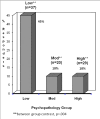Psychopathology predicts the outcome of medial branch blocks with corticosteroid for chronic axial low back or cervical pain: a prospective cohort study
- PMID: 19220916
- PMCID: PMC2652420
- DOI: 10.1186/1471-2474-10-22
Psychopathology predicts the outcome of medial branch blocks with corticosteroid for chronic axial low back or cervical pain: a prospective cohort study
Abstract
Background: Comorbid psychopathology is an important predictor of poor outcome for many types of treatments for back or neck pain. But it is unknown if this applies to the results of medial branch blocks (MBBs) for chronic low back or neck pain, which involves injecting the medial branch of the dorsal ramus nerves that innervate the facet joints. The objective of this study was to determine whether high levels of psychopathology are predictive of pain relief after MBB injections in the lumbar or cervical spine.
Methods: This was a prospective cohort study. Consecutive patients in a pain medicine practice undergoing MBBs of the lumbar or cervical facets with corticosteroids were recruited to participate. Subjects were selected for a MBB based on operationalized selection criteria and the procedure was performed in a standardized manner. Subjects completed the Brief Pain Inventory (BPI) and the Hospital Anxiety and Depression Scale (HADS) just prior to the procedure and at one-month follow up. Scores on the HADS classified the subjects into three groups based on psychiatric symptoms, which formed the primary predictor variable: Low, Moderate, or High levels of psychopathology. The primary outcome measure was the percent improvement in average daily pain rating one-month following an injection. Analysis of variance and chi-square were used to analyze the analgesia and functional rating differences between groups, and to perform a responder analysis.
Results: Eighty six (86) subjects completed the study. The Low psychopathology group (n = 37) reported a mean of 23% improvement in pain at one-month while the High psychopathology group (n = 29) reported a mean worsening of -5.8% in pain (p < .001). Forty five percent (45%) of the Low group had at least 30% improvement in pain versus 10% in the High group (p < .001). Using an analysis of covariance, no baseline demographic, social, or medical variables were significant predictors of pain improvement, nor did they mitigate the effect of psychopathology on the outcome.
Conclusion: Psychiatric comorbidity is associated with diminished pain relief after a MBB injection performed with steroid at one-month follow-up. These findings illustrate the importance of assessing comorbid psychopathology as part of a spine care evaluation.
Figures



Similar articles
-
Medial Branch Blocks or Intra-Articular Injections as a Prognostic Tool Before Lumbar Facet Radiofrequency Denervation: A Multicenter, Case-Control Study.Reg Anesth Pain Med. 2015 Jul-Aug;40(4):376-83. doi: 10.1097/AAP.0000000000000229. Reg Anesth Pain Med. 2015. PMID: 26066382
-
Comparative outcomes of a 2-year follow-up of cervical medial branch blocks in management of chronic neck pain: a randomized, double-blind controlled trial.Pain Physician. 2010 Sep-Oct;13(5):437-50. Pain Physician. 2010. PMID: 20859313 Clinical Trial.
-
Therapeutic cervical medial branch blocks in managing chronic neck pain: a preliminary report of a randomized, double-blind, controlled trial: clinical trial NCT0033272.Pain Physician. 2006 Oct;9(4):333-46. Pain Physician. 2006. PMID: 17066118 Clinical Trial.
-
Efficacy of Steroid Facet Joint Injections for Axial Spinal Pain and Post Radiofrequency Ablation Neuritis: A Systematic Review.Curr Pain Headache Rep. 2025 Feb 21;29(1):53. doi: 10.1007/s11916-025-01369-0. Curr Pain Headache Rep. 2025. PMID: 39982588
-
Predictors of Outcomes After Lumbar Intra-Articular Facet Joint Injections and Medial Branch Blocks: A Scoping Review.Spine (Phila Pa 1976). 2023 Oct 15;48(20):1455-1463. doi: 10.1097/BRS.0000000000004776. Epub 2023 Jul 20. Spine (Phila Pa 1976). 2023. PMID: 37470372 Free PMC article.
Cited by
-
Evidence-based radiology (part 1): Is there sufficient research to support the use of therapeutic injections for the spine and sacroiliac joints?Skeletal Radiol. 2010 Jan;39(1):5-9. doi: 10.1007/s00256-009-0783-x. Skeletal Radiol. 2010. PMID: 19730856 Review.
-
Predictors of Response to a Medial Branch Block: MRI Analysis of the Lumbar Spine.J Clin Med. 2019 Apr 19;8(4):538. doi: 10.3390/jcm8040538. J Clin Med. 2019. PMID: 31010137 Free PMC article.
-
Relationship of negative affect and outcome of an opioid therapy trial among low back pain patients.Pain Pract. 2013 Mar;13(3):173-81. doi: 10.1111/j.1533-2500.2012.00575.x. Epub 2012 Jun 11. Pain Pract. 2013. PMID: 22681407 Free PMC article. Clinical Trial.
-
Sex differences in the stability of conditioned pain modulation (CPM) among patients with chronic pain.Pain Med. 2013 Nov;14(11):1757-68. doi: 10.1111/pme.12220. Epub 2013 Aug 7. Pain Med. 2013. PMID: 23924369 Free PMC article.
-
A comparison of physical and psychological features of responders and non-responders to cervical facet blocks in chronic whiplash.BMC Musculoskelet Disord. 2013 Nov 4;14:313. doi: 10.1186/1471-2474-14-313. BMC Musculoskelet Disord. 2013. PMID: 24188899 Free PMC article.
References
-
- Sehgal N, Dunbar EE, Shah RV, Colson J. Systematic review of diagnostic utility of facet (zygapophysial) joint injections in chronic spinal pain: an update. Pain Physician. 2007;10:213–228. - PubMed
Publication types
MeSH terms
Substances
Grants and funding
LinkOut - more resources
Full Text Sources
Medical

